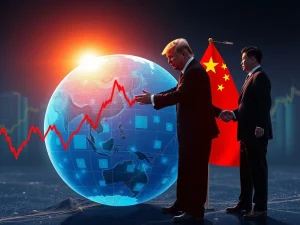Unprecedented Surge: Hong Kong Stock Connect Hits Record HK$820 Billion in Mainland China Investment

In the dynamic world of finance, understanding where capital flows is crucial for anyone navigating investment opportunities, including those keenly watching the cryptocurrency space. Just as digital assets thrive on liquidity and market sentiment, traditional markets like Hong Kong are experiencing significant shifts. This year, the Hong Kong Stock Connect program has become a focal point, witnessing an extraordinary surge in capital, setting new records that highlight evolving financial landscapes.
What’s Driving the Record Hong Kong Stock Connect Inflow?
The year 2025 marks a pivotal moment for Hong Kong’s financial markets. The Stock Connect program, a vital link between mainland China’s exchanges and Hong Kong, has facilitated an unprecedented influx of capital. Investments from mainland China into Hong Kong through this scheme have reached a staggering HK$820 billion ($104 billion) year-to-date. This figure not only surpasses the previous year’s record of HK$807.9 billion but also underscores a profound deepening of financial integration between the two regions.
Since its inception in 2014, the total value of inflows via Stock Connect has exceeded HK$4.5 trillion, with a significant HK$1.5 trillion occurring in just the last two years. This accelerated pace of capital inflow reshapes trading dynamics and investment strategies for both institutional and retail investors.
The Power of Mainland China Investment: Tech Stocks and AI Innovation
A primary catalyst for this substantial Mainland China investment is the allure of Hong Kong-listed tech giants. Companies like Tencent and Alibaba, while prominent, remain largely inaccessible to mainland investors due to China’s stringent capital controls. The Stock Connect program offers a regulated gateway, providing mainland investors with direct access to these high-growth technology firms.
The rebound in shares of these companies has been further amplified by several factors:
- Easing Regulatory Pressures: A more predictable regulatory environment in China has bolstered investor confidence in the tech sector.
- Breakthroughs in Domestic AI: Innovations, such as DeepSeek’s large language model, have ignited enthusiasm for Chinese tech firms, translating into increased investment.
This flow indicates a strategic shift in how mainland capital is deployed, seeking growth avenues beyond domestic limitations.
Understanding Capital Inflow Dynamics in the Hong Kong Market
The surge in southbound transactions—funds moving from mainland China into Hong Kong—has dramatically altered the trading landscape. These transactions now account for over 50% of daily trading volume on Hong Kong’s main board, a sharp increase from under 20% in 2019. This demonstrates Hong Kong’s evolving function within the broader Chinese financial ecosystem.
Here’s a snapshot of the record-breaking capital flow:
| Metric | Value (2025 YTD) | Comparison (2024) |
|---|---|---|
| Mainland Inflow via Stock Connect | HK$820 Billion | HK$807.9 Billion |
| Total Inflow (Since 2014) | HK$4.5 Trillion | N/A |
| Inflow (Last 2 Years) | HK$1.5 Trillion | N/A |
How Are Policymakers Supporting Cross-border Investment?
Policymakers have actively fostered this trend, recognizing Hong Kong’s strategic importance. At a January 2025 conference, People’s Bank of China Governor Pan Gongsheng outlined plans to support “more high-quality enterprises” listing and issuing bonds in Hong Kong. Additionally, there are intentions to increase the allocation of national foreign exchange reserves to the city. These measures signal strong governmental backing for Hong Kong’s role as a financial gateway.
These initiatives follow significant 2024 regulatory changes by the China Securities Regulatory Commission (CSRC) aimed at streamlining cross-border investment and tightening market integration. Such reforms have already spurred a record IPO pipeline in Hong Kong, indicating a robust future for new listings and capital formation.
Hong Kong Market’s Evolving Identity: From Global Hub to Domestic Reservoir?
While Hong Kong has historically served as a crucial international financial hub, the current surge in capital inflow primarily reflects a reallocation of wealth within China rather than a broad global investment trend. Domestic capital, seeking higher returns amidst a stagnant real estate sector and regulatory uncertainties in other industries, is increasingly finding its way to Hong Kong.
Policymakers continue to emphasize Hong Kong’s role in fostering market openness. However, the sheer dominance of mainland funds underscores the city’s evolving function: it is increasingly acting as a domestic capital reservoir, a conduit for Chinese wealth, rather than solely a traditional offshore gateway for international funds.
Conclusion
The record-breaking capital inflow into Hong Kong via Stock Connect in 2025 marks a significant chapter in the financial integration of mainland China and Hong Kong. Driven by mainland investors’ hunger for tech stocks and supported by proactive policy measures, this surge highlights Hong Kong’s enduring appeal as a financial center. As the city adapts to its evolving role as a key reservoir for domestic Chinese capital, its dynamics will continue to influence regional and potentially global financial markets, offering new perspectives for investors across all asset classes, including the crypto market.
Frequently Asked Questions (FAQs)
Q1: What is the Hong Kong Stock Connect program?
The Hong Kong Stock Connect is a mutual market access program that allows investors in mainland China and Hong Kong to trade shares on each other’s stock exchanges through their local brokers. It provides a regulated channel for cross-border capital flow.
Q2: How much capital inflow has Hong Kong received via Stock Connect in 2025?
As of 2025 year-to-date, Hong Kong has received a record HK$820 billion (approximately $104 billion) in capital inflow from mainland China through the Stock Connect program.
Q3: What factors are driving this record Mainland China investment?
Key drivers include mainland investors’ desire to access Hong Kong-listed tech stocks (like Tencent and Alibaba) that are otherwise restricted, easing regulatory pressures on the tech sector, and breakthroughs in domestic AI innovation.
Q4: How has the capital inflow impacted Hong Kong’s trading dynamics?
Southbound transactions (mainland funds into Hong Kong) now account for over 50% of daily trading volume on Hong Kong’s main board, a significant increase from under 20% in 2019, indicating a major shift in market participation.
Q5: What is Hong Kong’s evolving role in the global financial landscape?
While historically an international financial hub, the current surge of domestic capital suggests Hong Kong is increasingly functioning as a domestic capital reservoir for Chinese wealth, adapting its role within China’s financial system.
Q6: Are there any policy measures supporting this cross-border investment trend?
Yes, policymakers, including the People’s Bank of China Governor, have announced plans to support more high-quality enterprises listing in Hong Kong and to increase the allocation of national foreign exchange reserves to the city, alongside regulatory changes to streamline cross-border listings.










